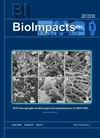Essential role of CD38 in platelet aggregation through the PKC- mediated internalization and activation
IF 2.2
4区 工程技术
Q3 PHARMACOLOGY & PHARMACY
引用次数: 0
Abstract
Introduction: CD38 is a multifunctional enzyme with a potent Ca2+ mobilizing effect, cyclic ADP-ribose (cADPR), and nicotinic acid adenine dinucleotide phosphate (NAADP). Here, we aimed to demonstrate the role of CD38 in platelets via protein kinase C (PKC)-mediated internalization and activation. Methods: Mouse platelets were used in this study. Thrombin, an agonist of platelet function, provoked a prompt and long-lasting increase in intracellular Ca2+ concentration ([Ca2+]i), resulting from an interplay of multifold Ca2+ mobilizing messengers.The signaling pathway was delineated using different inhibitors and techniques such as platelet aggregation assay, intracellular calcium measurements, immunoprecipitation, immunoblotting, and flow cytometry. Results: We observed a sequential formation of cADPR and NAADP through CD38 activation by PKC of non-muscle myosin heavy chain IIA (MHCIIA), resulting in phospholipase C (PLC) activation in the thrombin-stimulated platelets. These findings reveal that PKC is fundamental in activating CD38 and elicits a physiological response in the murine platelets. Conclusion: PKC is involved in many signaling pathways. Specifically, PKC is involved in the internalization of CD38 via MHCIIA in CD38+/+ wild-type (WT) and CD38-/- knockout mice (KO). CD38 generates calcium-mobilizing agents that act on specific receptors of the calcium stores. Calcium triggered platelet aggregation while serving as a secondary messenger.CD38通过PKC介导的内化和激活在血小板聚集中的重要作用
CD38是一种多功能酶,具有强大的Ca2+动员作用,环adp核糖(cADPR)和烟酸腺嘌呤二核苷酸磷酸(NAADP)。在这里,我们旨在通过蛋白激酶C (PKC)介导的内化和激活来证明CD38在血小板中的作用。方法:采用小鼠血小板进行实验。凝血酶是血小板功能的激动剂,引起细胞内Ca2+浓度([Ca2+]i)的迅速和持久的增加,这是由多重Ca2+动员信使的相互作用引起的。使用不同的抑制剂和技术,如血小板聚集测定、细胞内钙测量、免疫沉淀、免疫印迹和流式细胞术,描绘了信号通路。结果:我们观察到,通过PKC激活非肌球蛋白重链IIA (MHCIIA)的CD38,导致凝血酶刺激的血小板中磷脂酶C (PLC)激活,cADPR和NAADP序列形成。这些发现表明PKC是激活CD38的基础,并在小鼠血小板中引发生理反应。结论:PKC参与多种信号通路。具体来说,PKC在CD38+/+野生型(WT)和CD38-/-敲除小鼠(KO)中通过MHCIIA参与CD38的内化。CD38产生钙动员剂,作用于钙储存的特定受体。钙作为次级信使触发血小板聚集。
本文章由计算机程序翻译,如有差异,请以英文原文为准。
求助全文
约1分钟内获得全文
求助全文
来源期刊

Bioimpacts
Pharmacology, Toxicology and Pharmaceutics-Pharmaceutical Science
CiteScore
4.80
自引率
7.70%
发文量
36
审稿时长
5 weeks
期刊介绍:
BioImpacts (BI) is a peer-reviewed multidisciplinary international journal, covering original research articles, reviews, commentaries, hypotheses, methodologies, and visions/reflections dealing with all aspects of biological and biomedical researches at molecular, cellular, functional and translational dimensions.
 求助内容:
求助内容: 应助结果提醒方式:
应助结果提醒方式:


